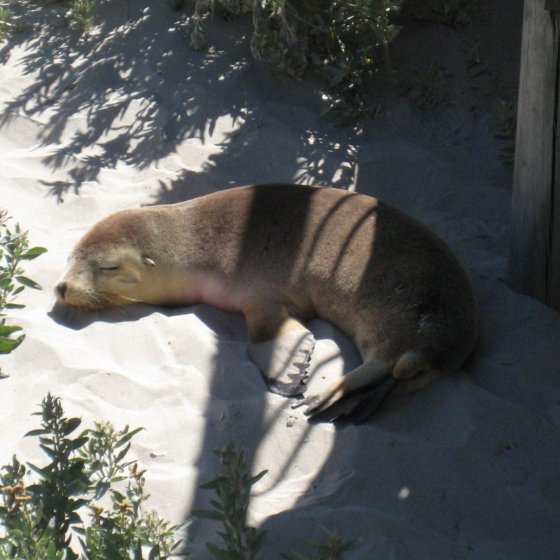- Home
- Environmental Themes
- Sea
- State of Our Sea
- Flora and Fauna
Flora and Fauna
Biodiversity
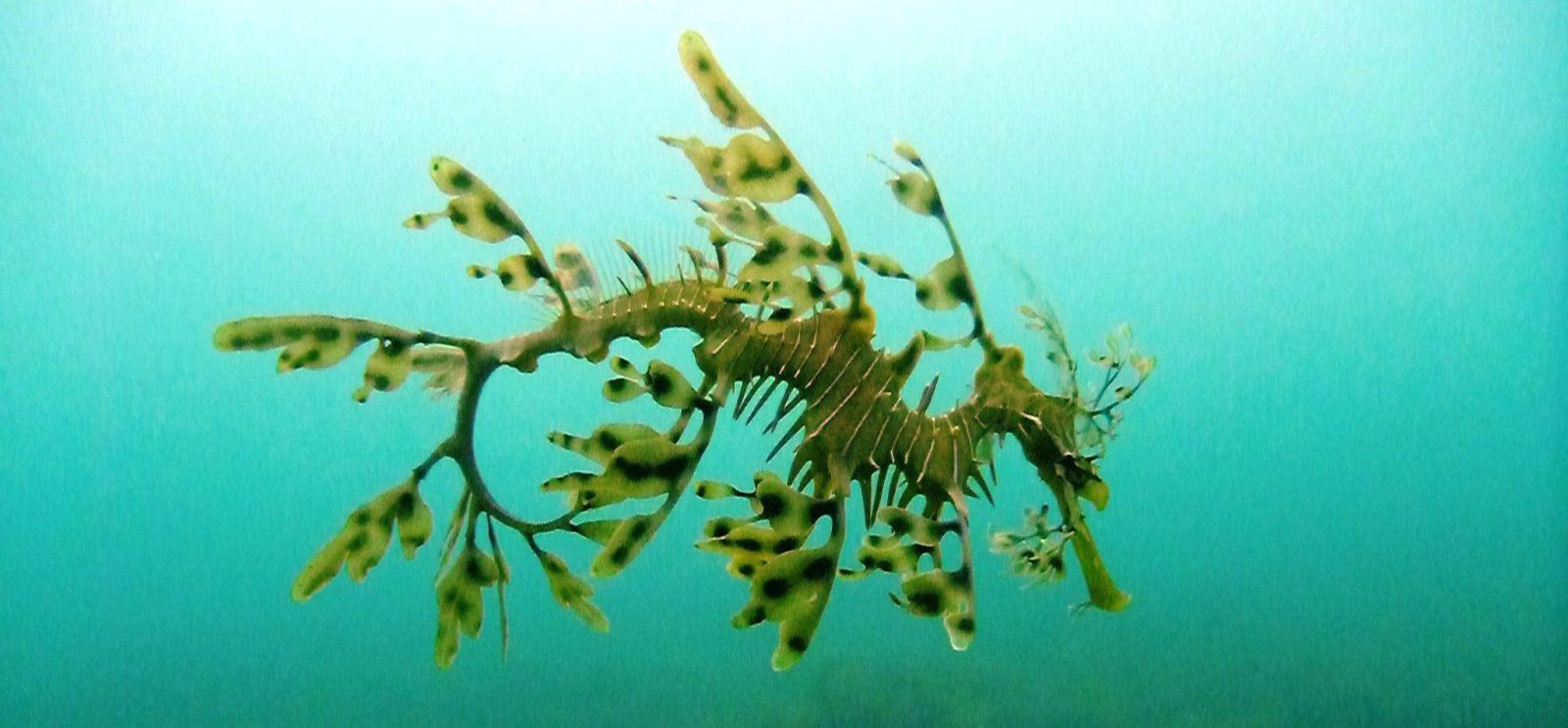


The percentage of native flora declining in South Australia is based on an assessment for 113 of 179 coastal species. When compared with a 2002 baseline, this declining trend is getting worse in six landscape regions, which includes Hills and Fleurieu, Eyre Peninsula, Kangaroo Island, Northern and Yorke, Murraylands and Riverland, and Limestone Coast.
The percentage of native fauna declining has stabilised based on the assessment for 96 of 165 coastal and marine native fauna species. When compared with a 2002 baseline, this trend is improving in four landscape regions, which includes Hills and Fleurieu, Kangaroo Island, Northern and Yorke and SA Arid Lands. The declining trend has stabilised in three landscape regions including Eyre Peninsula, Murraylands and Riverland, and Limestone Coast.
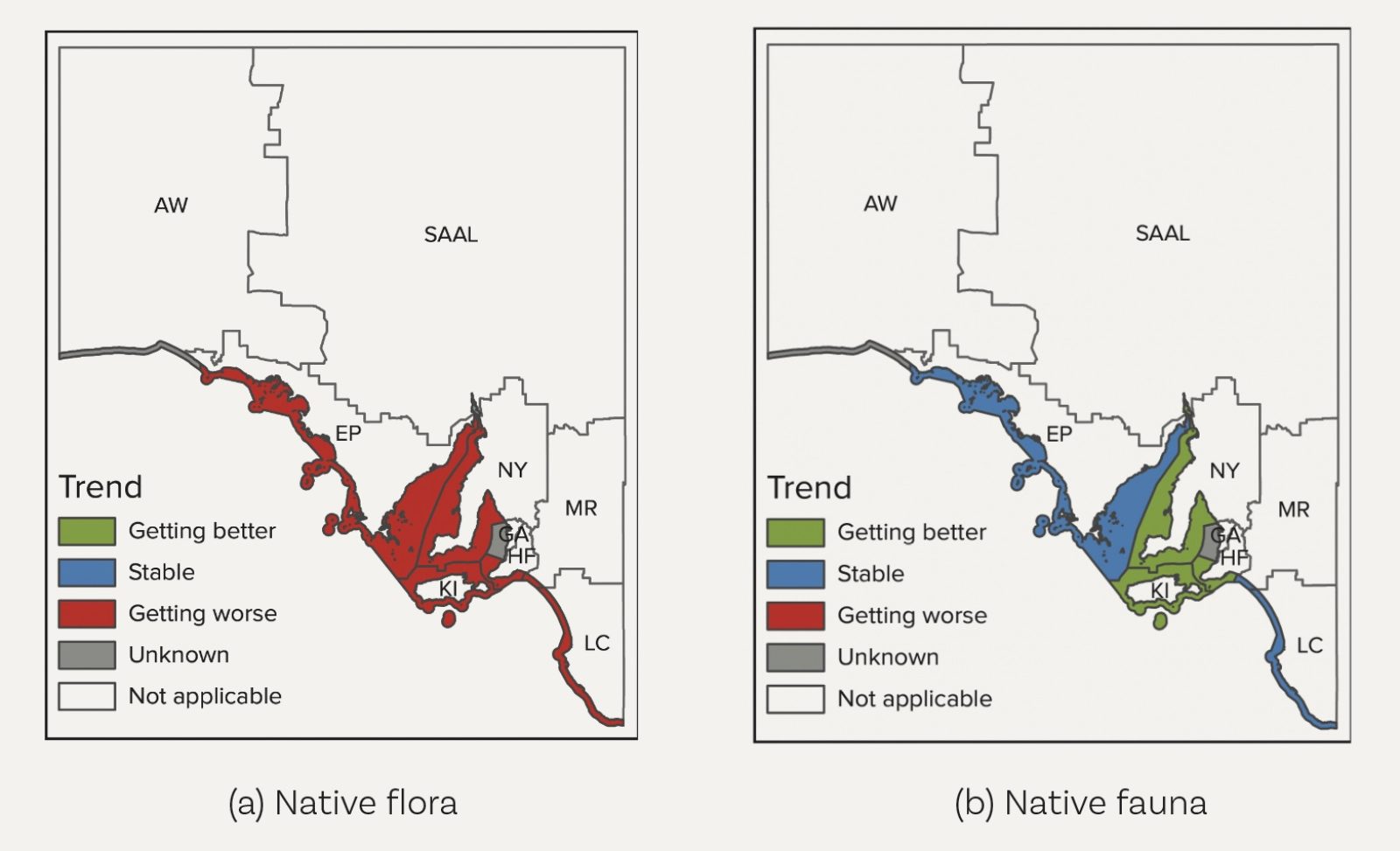
Species were defined as 'declining' if the rate at which they were recorded showed a greater than 90% chance of reduction between 2002 and 2022. An estimated 49.2% of coastal and marine native flora and 22.6% coastal and marine native fauna species are declining in South Australia, which varies between regions. However, the condition was rated unknown as there are no agreed benchmarks for coastal and marine flora and fauna.
The Australian Government has developed a Threatened Species Action Plan 2022–23 that will focus efforts on priority species around Australia. There are 110 species listed in total, which include both flora and fauna. Nine species on this list live in coastal and marine environments and four of these can be found in South Australia, and include:
SA Flora and Fauna Data Dashboard provides data on numbers of rare, endangered and vulnerable species for South Australia. Note: this data also includes terrestrial and inland aquatic flora and fauna.
Hooded Plovers are an endangered bird that live on beaches in South Australia. They lay their eggs in shallow bowl-like holes on open sand and are, therefore, susceptible to human disturbance from walking, 4WDing and pet dogs, as well as predators such as foxes and cats. It is estimated that there are fewer than 800 birds left in the wild in South Australia. There are a number of research and monitoring programs being undertaken in South Australia and throughout Australia that are showing the number of ‘Hoodies’ are starting to increase. BirdLife Australia is partnering with several stakeholders, including Landscape Boards, councils and Aboriginal corporations to deliver the Eastern Hooded Plover Project.
Southern Right Whales and Humpback Whales can be sighted from the Far West Coast Marine Park at the Head of the Bight and along the coast through to Encounter Bay. Southern Right Whales are listed as an endangered species under the Environment Protection and Biodiversity Conservation Act 1999.
South Australia has three species of dolphins, with two species of bottlenose dolphin and the common dolphin. Further investigations are being undertaken into the Port River dolphin deaths that have occurred within the Adelaide Dolphin Sanctuary. A select committee was established in June 2022 to inquire into and report on further legislative and policy measures to better protect dolphins in the Adelaide Dolphin Sanctuary. The interim report made 14 recommendations. Fishing restrictions within the Adelaide Dolphin Sanctuary were imposed to help protect dolphins. However, the exact cause of the disappearance and deaths of these dolphins is still unknown.
Fisheries
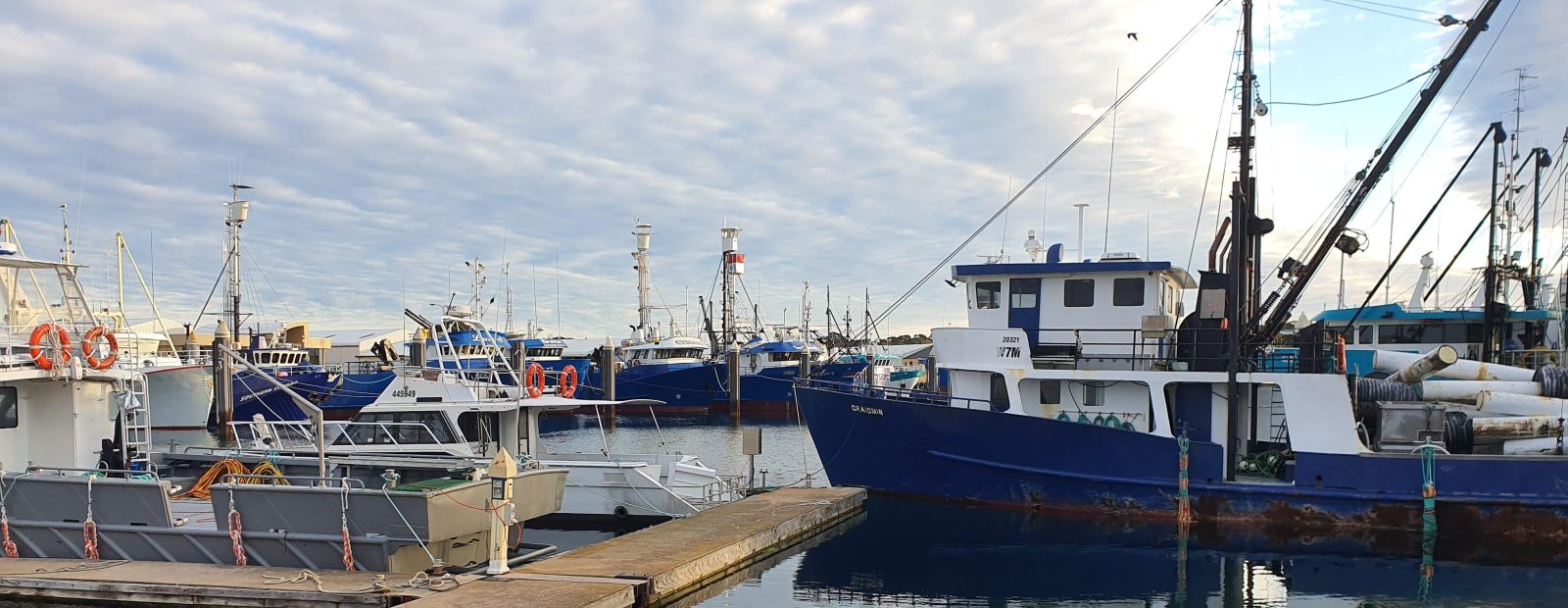
South Australia is known for its table fish, such as King George Whiting, Southern Garfish, Southern Calamari, Snapper and Flathead. Fishers also target juvenile Australian Salmon, Snook, Tommy Ruff (Australian Herring), Yellow-eye Mullet, Mulloway, Yellowtail Kingfish and other species.
PIRSA is responsible for the regulation of commercial and recreational fishing, managing aquatic biosecurity, and the sustainable development of aquaculture in South Australia. SARDI’s aquatic science division undertakes research to support the sustainable use of marine resources while protecting the ecology of South Australia’s aquatic environments.
Maintaining the sustainability of South Australia’s fisheries supports healthy ecosystems, regional economies through tourism, and recreational and commercial fishing, and provides for traditional fishing.

In 2022, 79% of fish stocks were classified as sustainable in South Australia with more than 75% of fish stocks remaining stable since 2012 (Figure 34). However, 6 South Australian stocks have transitioned to a worse category during this period, including Central Zone Blacklip and Greenlip Abalone, Gulf St Vincent and Spencer Gulf/West Coast Snapper, northern Gulf St Vincent Southern Garfish, and West Coast Western King Prawn. Northern Spencer Gulf Southern Garfish transitioned from depleting to recovering.
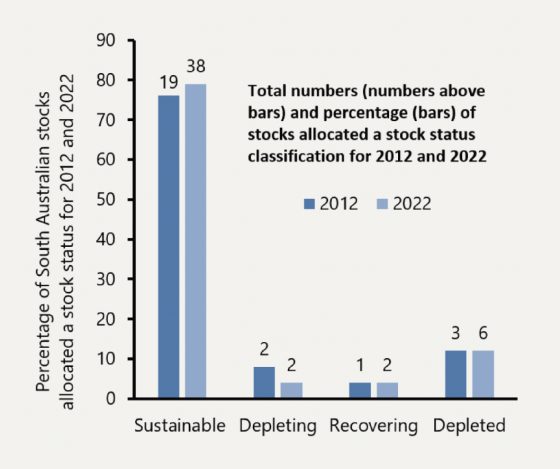
Snapper fish stocks in the West Coast/Spencer Gulf and Gulf St Vincent/Kangaroo Island areas remain classified as depleted, characterised by low biomass and poor recruitment over the past ten years.
- Gulf St Vincent: Estimated biomass has declined by 92% from 4,300 t (±104) in 2011 to 343 t (±67) in 2022.
- Spencer Gulf/West Coast: Estimated biomass has declined by 90% from 5,244 t (±104) in 2005 to 543 t (±65) in 2022.
The Snapper fishery in Gulf St Vincent, Spencer Gulf and west coast of South Australia has been closed since 1 November 2019. Considering the 2022 stock assessment still indicated that Snapper stocks remain depleted, the Snapper fishery remains closed until 30 June 2026 to help its recovery. Research and management is being undertaken to assist recovery of snapper stocks and protect stocks for the future.
All King George Whiting and Southern Calamari were classified as sustainable, with Southern Garfish classified as recovering in both Gulf St Vincent and Spencer Gulf as per the 2021–22 SARDI annual assessment.
A dashboard on the sustainability and classification of fish stocks in South Australia is provided by FRDC.
Invasive Species and Diseases
Biosecurity is currently regulated under a number of different Acts in South Australia. The South Australian Government is developing a new Biosecurity Bill for South Australia that proposes to create a modern, flexible and responsive biosecurity framework and improve the management of biosecurity across industries including the management of aquatic pests.
South Australia is largely free of marine pests with the trend in abundance and distribution, and incursion of new invasive species stable across the state. Boats and vessels present the greatest risk of spreading marine pests and diseases with the highest detections generally found around ports and marinas. They can also be spread via stock translocations and movement of marine infrastructure. PIRSA are primarily responsible for managing aquatic pests and diseases in South Australia.
However, several identified aquatic pests threaten South Australia, including exotic (species not native to South Australia and/or Australia) and some established species (exotic species detected in South Australia) that could establish or spread further. Marine pests can reproduce quickly, and rapidly spread to new areas where they compete with native species by preying upon them and outcompeting them for space, light and food. They can also introduce diseases and parasites to our native species.
Reports for suspected aquatic pests and diseases can be made by calling the Fishwatch hotline or using the SA Fishing app that has an online reporting system.
The most noted diseases of concern for South Australia include:
- Abalone viral ganglioneuritis (AVG) that has not been found in South Australia, but is known to occur in Australia including Victoria and Tasmania.
- Pacific oyster mortality syndrome (POMs) with the first case recorded in 2010 in New South Wales. It was later recorded in 2016 in Tasmania, and then discovered in the Port River in 2018. This disease causes almost 100% mortality of Pacific Oysters within a few days. POMs has not made its way into the oyster growing regions within South Australia.
- Perkinsus olseni that impacts abalone, and occurs in South Australian waters and is a notifiable disease.
- White spot disease that impacts crustaceans. This disease is highly contagious and can result in 100% mortality within a few days. It was first detected in Australia in 2016–17 in Queensland prawn farms and was more recently detected in a bio-secure prawn farm in New South Wales. There are strict importation protocols in place to minimise the risk of this disease arriving in South Australia.


Based on public reporting between 2019 and 2022, most invasive species had not spread past the localised area where they have historically been reported. During this time, 6 exotic species were reported in South Australia, all within the Green Adelaide region. Of these, 3 reports were confirmed, 2 reports were possible and 1 report related to detection on a transit vessel. By way of comparison, there were 2 new exotic species detected during 2015–19.
